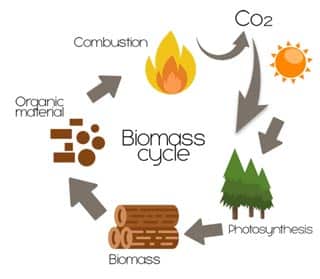Biomass Power and Benefits of Biopower
Exploring the 7 Benefits and Sources of Biomass Power
![]() In the quest to find more sustainable and eco-friendly energy sources, Biomass Power or just simply, Biopower has emerged as a promising solution in generating electricity from the chemical energy contained within organic matter.
In the quest to find more sustainable and eco-friendly energy sources, Biomass Power or just simply, Biopower has emerged as a promising solution in generating electricity from the chemical energy contained within organic matter.
Biomass comprises all forms of natural and organic materials derived from plants and animal wastes with many different types of biomass suitable for power production, including wood waste, agricultural residue, animal waste, and energy crops to generate both electricity and heat, or for converting into biofuels.
Biomass (which literally means biological matter) itself can be used and burnt in solid form or converted to bio-gases, (methane) and bio-liquids, (ethanol) using a variety of refining and distilling processes. Solid wooden forms of biomass is the oldest source of renewable energy known to man, dating back to the beginning of time with discovery of fire.

Unlike traditional fossil fuels, such as coal and oil, biomass is fully renewable and can significantly reduce our greenhouse gas emissions.
Unlike coal-fired or gas-fired power stations, biomass power plants do not contribute to the increased levels of greenhouse gases. Since the level of carbon dioxide generated in the combustion process of biofuels is no greater than the amount of carbon dioxide produced during the natural photosynthesis process of living plants.
Then in a world struggling with a climate change crisis due to ever changing weather patterns, biomass power appears as an alternative renewable energy source to burning conventional fossil fuels. To this end, this alternative energy tutorial delves into the numerous benefits biomass power can offer, while exploring its sources and highlighting its pivotal role in shaping a greener future.
7 Benefits of Biomass Power
1. Renewable Energy Source:
Biomass is a replenishable resource utilizing organic materials, making it a sustainable and renewable energy source which can be replenished relatively quickly. As long as there are forests, crops, and organic waste, biomass will continue to be available. For example, crops can be replanted each year, and trees can be regrown. This is in contrast to fossil fuels, such as coal and oil, which take millions of years to form and which cannot be easily replenished.
However, it is important to note that the sustainability of biomass power can vary depending on how the biomass is sourced and used. For example, if biomass is harvested from unsustainable forest management practices, or if it is burned in inefficient power plants, it can have negative environmental impacts. Then it is important to choose sustainable biomass resources and to use them in efficient ways.
2. Reduction in Greenhouse Gas Emissions:
Biomass power, or simply biopower, is considered carbon-neutral because the carbon dioxide released during combustion is offset by the carbon absorbed during the growth of plants. When organic materials are burned for energy, the carbon dioxide they release is part of the natural carbon cycle, as plants absorb CO2 during their growth. This balance helps mitigate the effects of climate change by reducing overall greenhouse gas emissions. But effective management and policies are required to ensure the combustion of biomass contributes to lowering greenhouse gas emissions and not adding to them.
3. Waste Utilization and Management:
Biomass power encourages the use of organic waste materials such as wood waste, agricultural waste, and municipal solid waste. These waste materials can be burned or converted into other forms of energy, such as biogas, biodiesel, and ethanol. By converting these waste materials into other forms of wood biomass energy, biomass power contributes to efficient waste management by reducing the amount of waste that goes into landfills, saving space and reducing greenhouse gas emissions.
4. Supports Rural Economies:
Biopower energy production often involves local farmers and forestry industries, creating jobs and supporting local economies, stimulating growth in rural areas. Biomass power plants such as the waste-to-energy plants which burn solid waste to generate electricity can create jobs in the collection, transportation and processing of the biomass waste, as well as in the operation and maintenance of these power plants. Thus providing livelihoods for people in rural areas.
5. Energy Independence:
Biopower can help to provide energy independence, since being a renewable energy source, it can be used to generate electricity, heat homes and businesses, and power vehicles. This means that countries that have access to biomass resources can reduce their reliance on imported fossil fuels and the global challenges that they bring. This independence also enhances energy security and stability, ensuring a consistent energy supply for the nation.
6. Flexibility in Energy Production:
Biomass power plants can provide flexibility in energy production. They can be adjusted up and down quickly to meet changes in energy demands, providing flexibility in electricity production. This is important for integrating variable renewable energy sources, such as solar and wind power, into the grid since is not dependent on weather conditions, making it a reliable energy option. Biomass power plants can also be used to provide backup power in case of outages as they can operate independently from the national utility grid.
7. Soil Health and Biodiversity:
Biomass cultivation, especially perennial grasses and trees, can improve soil health, prevent erosion, and promote biodiversity. Managed properly, biomass production can coexist with natural ecosystems, fostering a harmonious relationship between energy production and environmental conservation.
However, one major challenge is that biomass production can compete with food production for the available land and resources. Additionally, if biomass is not sustainably managed, it can have negative environmental impacts, such as deforestation and air pollution.
Sources of Biomass Power
- Forestry Residues: – Biomass power plants utilize residues from forestry operations, such as branches, bark, and sawdust. These by-products are transformed into energy, reducing the environmental impact of forestry activities.
- Agricultural Residues: – Crop residues like corn stalks, rice husks, and wheat straw are valuable sources of biomass energy. By using these agricultural leftovers, farmers can contribute to energy production while promoting sustainable agricultural practices.
- Dedicated Energy Crops: – Certain crops, like switchgrass and miscanthus, are grown specifically for biomass energy production. These high-yield, low-input energy crops provide a reliable biomass source without competing with normal food crops.
- Organic Wastes: – Biomass power plants can process organic waste materials from households, industries, and farms. This includes food waste, animal manure, and sewage sludge. Recycling these organic materials for energy production reduces landfill usage and harmful greenhouse gas emissions.
- Algae and Aquatic Plants: – Algae and aquatic plants, such as seaweed and kelp, can be cultivated in ponds and wastewater treatment facilities. These fast-growing water-based plants capture the suns solar energy which can be converted into seaweed energy, offering a continuous source of renewable energy.
- Municipal Solid Waste, (MSW): – Biomass power plants can incinerate municipal solid waste to generate electricity. This not only reduces the volume of waste in landfills but also produces energy from materials that would otherwise go to waste.
Biomass Power Summary
Biomass Power, also known as Biopower, is a flexible energy source that can be used to meet a variety of needs in the transition towards a sustainable energy future. By harnessing the power of nature’s organic materials, societies can meet their energy needs while preserving the environment for future generations.
Overall, biopower is a promising technology for waste utilization and management as it can help reduce the amount of waste that goes to landfills, generate renewable energy, and create jobs. As technology advances and awareness spreads, biomass power is poised to play a pivotal role in shaping a cleaner, greener, and more sustainable world.
However, it is important to note that biomass power is not without its challenges. The sustainability of biomass power can vary depending on how the biomass is sourced and used. For example, if biomass is harvested from unsustainable forest management practices, or if it is burned in inefficient power plants, it can have negative environmental impacts.
Biomass peat pellets from sphagnum moss is also controversial since the environmental damage caused from harvesting the peat in terms of altering the landscape and disturbing the wildlife which live there. Also, peatlands are important carbon storage areas, locking away billions of tons of carbon in the ground which becomes released when the peatlands are excavated. Then it is important to sustainably source biomass waste and to use it in more efficient ways.
Then biomass power is a renewable energy source that can help to reduce our reliance on fossil fuels, curtail greenhouse gas emissions, fosters economic growth, supports local communities, and promotes responsible waste management. All while generating electrical energy at the same time. Then, biomass power truly is a promising technology for our future energy independence.
Learn More
To learn more about biomass power, or to obtain more information about the various biomass energy technologies available. Or maybe you just want to explore the advantages and disadvantages of Biomass and how you can use it in your home to combating climate change. Then get your copy about the Gasification of Waste Materials today direct from Amazon and learn how the or transforming of waste materials into energy through various gasification processes can turn them into a valuable resource.











Please Speak up!
We hope this Biomass Power Tutorial was useful and informative for you. Are you ready to share your thoughts
and experience with us and many others. Your comments are always welcome, just post them in the section below.
P.S. Don't forget to like, rate, and share this Alternative Energy Tutorials post. Thank you for using our website.